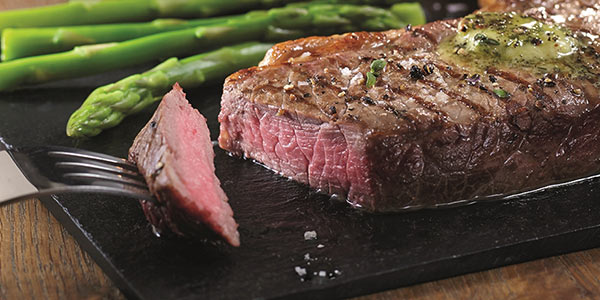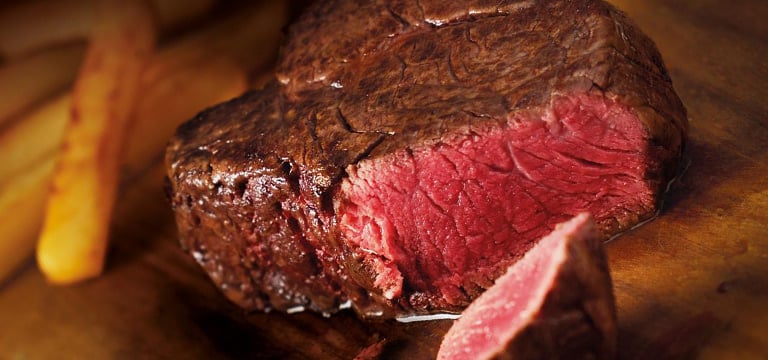From choosing the right cut to seasoning and getting the right char, check out our chef Jon’s top tips for making the most of your steak at home.
Choosing the right cut
To help you decide which type of steak is right for you, here Jon gives us the low down on popular cuts of steak:
Fillet steak - this is the most tender cut of steak as is usually the most expensive. It has very little fat on it to help it stay succulent during cooking. Fillet steak makes a delicious treat ideal for an at-home date night.
Rump steak - despite the unfortunate name, rump steak does come from the backside of a cow. It won’t be as tender as say, a sirloin, but it can be a much more flavoursome option.
Sirloin steak - like a fillet steak, sirloin is a real prime cut. It’s best served medium rare.
Ribeye steak - this cut can be one of the tastiest. They’re often veined with fat which creates a flavoursome, tender steak.
Choosing the right pan
Check out Jon’s advice on choosing the right pan to cook your steak in:
“For cooking steaks at their best, I would recommend a frying pan. When cooking indoors, use a heavy-bottomed frying or skillet/char grill style pan (the ones with the grill-like a bars down them), this helps to get a really good sear on the steak as they retain the heat well and will leave attractive bar marks on the outside of the steak. Cooking on a grill on a barbecue is a great way to cook steak as you don't get the smell all through your house, and if your temperatures are just right you can get a great cooked steak.”

Seasoning your steak
Check out Jon’s tips for seasoning your steak before cooking.
“If you want to really taste the quality of your steak, simply season it well with salt and pepper. You can season the steak before cooking, I like to brush the outside of the steak with a little oil and then season with salt and pepper. It doesn't really matter when you season the meat, some say it draws out the moisture in the steak but I’m not convinced, the longer you leave the salt on it will start to cure the beef but that would take hours - a few minutes before you are ready to cook won’t make that much difference and may even add to the overall taste. When frying in a pan, you can add a couple of garlic cloves and some sprigs of hard herbs like thyme or rosemary to add more flavour."
“Choose a flavourless oil like vegetable oil, groundnut oil or sunflower oil. When you are halfway through cooking you can add a few knobs of butter to the pan to help with flavour, but you will need to turn down the heat as the butter will burn at high temperatures. If you’re cooking on a barbecue, try using a basting butter or oil while you are cooking to add flavour and to keep the meat succulent while cooking.”
Getting a good char
For those delicious-looking char lines, check out Jon’s top tips below:
“The key to a great steak is getting the pan as hot as possible beforehand and searing the meat, this creates the char we are looking for, or the crust of the meat which is where all the flavour is. Sear the meat one side and then turn (depending on the recipe to char the other side, the other side won't char as well as the first side but if you keep turning the steak you will get an even cook). Also while charring, if you are cooking a steak with a wedge of fat on the side like a sirloin, using your tongs, hold this down on the surface of the pan to help char and render down some of this fat - this will all add to the final flavour of the steak. If you’re cooking on a barbecue get your coals super hot and white, try putting the lid down to really get the heat built up and get that charred crust of flavour on the steak.”

Cooking your steak how you like it
Cooking your steak to the way you like it is all about the timing. Here, Jon provides his guide on cooking your steak to your liking. Bear in mind that this will depend on the weight and thickness of your steak - if in doubt, you can ask the butcher at our counters for advice on cooking times. Jon also advises that there’s no right or wrong way to cook your steak, it all depends on your personal preference, but some cuts do benefit from less cooking.
Blue
The steak should still be a dark colour throughout, almost raw, and just warm, the outside will feel very spongy with no resistance when pushed down with your finger.
Rare
The steak will be dark red in colour with some red juice flowing when cut or as it is resting, like a blue steak it will feel spongy and soft with no resistance when poked.
Medium Rare
This will be more pink in colour with some juice, and will be soft and spongy with a slight spring.
Medium
This will be starting to feel firmer and less springy, and will be pale pink in the centre with hardly any juice.
Medium Well
This will be again getting firmer to the touch with a dark exterior and brownish pink colour in the centre with no juices or clear juices if present.
Well done
This will be firm and have hardly any pink colour. It’ll be more brown through the meat in the centre with clear juices, though should not be dry.

Steak cooking tips by cut
Fillet steak
Blue/Rare this will take about 1 1/2 minutes each side, and will be charred on both sides at a high heat, (allow to rest somewhere warm for at least double the time it was cooked)
To cook Medium Rare cook at around 2-3 minutes each side turning regularly and again rest for double that time.
For Medium and Medium to Well Done cook for around 3 minutes to 3 1/2 minutes and allow the resting time, and for well done cook for around 4-5 minutes both sides turning often, and allow for resting time.
Sirloin Steak/Rump Steak and Ribeye
Allowing for roughly a 2-3cm sliced steak the cook time should be around as follows:
For Blue, this will take approx 1 minute each side, with resting time. For Rare this will take about 1 1/2 minutes each side, Medium Rare will be about 2 minutes each side and for Medium it would be about 2 -1/2 minutes each side. For Medium to Well Done, this will take around 3 minutes each side, and for Well Done cook for around 4-5 minutes each side, always allowing for the resting time.

How to cook your steak
Follow Jon’s step-by-step advice on how to cook your steak for super tasty results.

How to check your steak is cooked to your liking
Make sure you’re about to enjoy a delicious dish with Jon’s tips for checking it’s cooked to your liking:
“There is no real foolproof method, it really comes from experience and practice, you can buy a thermometer and check the inside temperature (Blue/Rare will be about 54-57oc, Medium Rare to Medium will be between 60oc and 72oc and Medium Well to Well done will be 70oc to 75oc)”
Alternatively, trying using your fingers to prod the steak during cooking so you can get a feel for it - when it's rare it will be soft and pillowy, as it cooks it will firm up so medium will start to feel firm with a little give and as it cooks through it will become firmer and firmer with almost no give when prodded.”





